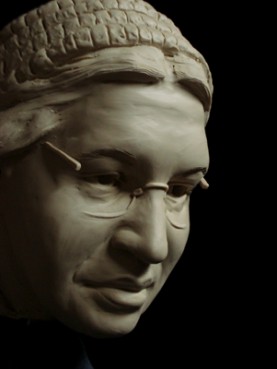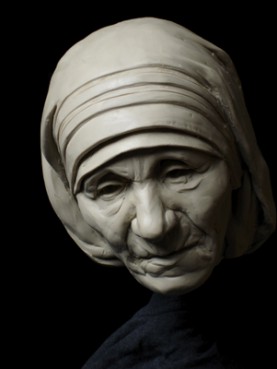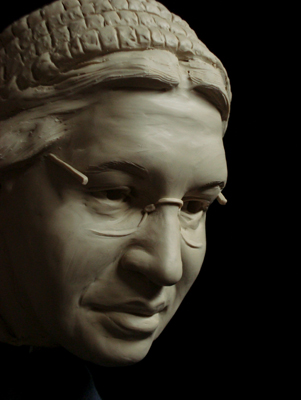WASHINGTON (RNS) Six feet above the vaulted entranceway to Washington National Cathedral, the rough contours of Rosa Parks' face are taking shape.

A clay model of Rosa Parks by North Carolina sculptor Chas Fagan will be used to carve a stone sculpture of the civil rights icon at Washington National Cathedral.
Using a motorized hammer and chiseling tools that date back centuries, stone carver Sean Callahan is patiently working on a new bust of the civil rights heroine.
“I have to be aware of the significance of it,” he said. “It puts pressure on me to get it right. I have to pay respect to her in that sense.”
Across the Human Rights “porch” in the cathedral's narthex, Parks will soon be joined by another famous woman, Mother Teresa.
Callahan, a 45-year-old Catholic, was not alive when Parks made history by staying seated on a segregated bus and helping spark the civil rights movement; but he remembers hearing about the Nobel Peace Prize-winning nun when he was growing up.
Starting with Parks, Callahan is using a pointing machine, whose brass arms adjust as he measures a plaster model that acts as an exact guide for the carving, which is chiseled from a block of stone in the narthex.
“It's kind of like a three-dimensional connecting the dots,” said the carver, dressed in jeans and a Washington Nationals baseball cap for the sometimes dusty work.
He carefully places the machine within 1/16th of an inch of the model before shifting the device to his stone canvas nearby.
“If you mismeasure this, then everything's off,” he explains.
The delicate details of Parks' face will slowly surface from what at first looks like a mass of dots and parallel chiseled lines. The dots indicate how far down he must chisel each part of the stone to develop the contours of the finished bust.
Eventually, he will have to leave the machine behind and do the final work by eye, which he says is the toughest part.
“Portraits are particularly difficult because everyone recognizes them,” he said. “If you're doing something like a hand or a gargoyle, it's not as critical. But it's an indefinable thing to make the face come alive. It's hard to explain, but that's just something that takes patience and practice to get the hang of.”
Callahan, who worked as an apprentice under stone carvers at the cathedral in the 1980s, has done restoration work on the White House exterior and gargoyles in private gardens. He was rehired by the cathedral six years ago.
As he stands amid temporary scaffolding, a carving of first lady Eleanor Roosevelt peeks over his shoulder.
Others already enshrined in the “human rights” portal include slain Salvadoran Archbishop Oscar Romero and Bishop John Walker, the first black Episcopal bishop of Washington.
“The people selected to appear in the iconography of the Human Rights Porch were chosen because of their extraordinary actions and contributions to the cause of human rights, social justice and the welfare of their fellow human beings,” said the Very Rev. Samuel T. Lloyd III, dean of the cathedral.
Callahan's work began a week before the country marked the birthday of the late Rev. Martin Luther King Jr., with whom Parks worked closely. The sculptures of Parks and Mother Teresa, based on clay models by North Carolina sculptor Chas Fagan, are due to be completed by Easter.

(RNS3-JAN18) A clay model of Mother Teresa by North Carolina sculptor Chas Fagan will be used to carve a stone sculpture of the Nobel laureate at Washington National Cathedral. For use with RNS-PARKS-CATHEDRAL, transmitted Jan. 18, 2011. RNS photo courtesy Chas Fagan.
“That quiet strength is, I think, the common denominator,” Fagan said of the two women he sculpted. “Rosa Parks definitely showed it with her actions and through her own life, and the same with Mother Teresa.”
Fagan, 45, based the hat Parks wears in his sculpture on the one she was wearing in the iconic photo of her on the bus in 1955. He said the flat hat of thick woven fabric was just like one his grandmother wore.
The placement of Parks in that photo, looking off to the right, determined her location on the left side of the portal. “Mother Teresa is a very recognizable image from all angles so I figured she would be OK with being on the right side,” said Fagan.
Without the aid of color, Fagan sculpted lines into Mother Teresa's habit to demonstrate the bands of blue in the white headscarf she wore.
Fagan, who crafted the sculpture of President Ronald Reagan that stands in the U.S. Capitol Rotunda, worked with cathedral craftsmen to complete the model so the faces of the women fit artistically within the cathedral's architecture. While he could “fix my mistakes” as he sculpted, he said there's “no wiggle room” when Callahan gets to the carving stage.
With these figures, the landmark cathedral that was officially finished in 1990 is educating worshippers just like the cathedrals of old, Fagan said.
“Now that the structural stuff is complete, there's a chance to do what all the other cathedrals did in their own time,” he said. “Just fill all the niches and teach through the art.”





